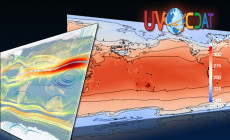Berkeley Researchers Honored for Contributions to Climate Data Analysis
May 11, 2015
by Linda Vu

Multiple visualization libraries can be accessed through the Ultrascale Visualization Climate Data Analysis Tools (UV-CDAT) system. The software program supports a wide range of one-, two- and three-dimensional visualization techniques, such as Data Visualization 3D (left) and ParaView plot (right).
Twelve researchers from the Lawrence Berkeley National Laboratory (Berkeley Lab) and UC Berkeley are among the recipients of the 2015 Federal Laboratory Consortium for Technology Transfer’s (FLC) Interagency Partnership Award. The team was honored for contributing a number of parallel analysis and visualization tools to the UV-CDAT, a powerful toolset that aids climate researchers in solving their most complex data analysis and visualization challenges.
The award was presented on April 29 at the 2015 FLC National Meeting in Denver, Colorado
“Prior to this project, there were no parallel tools for climate analysis. All of the existing climate analysis tools were 32-bit serial. The Berkeley contingent of this collaboration contributed new technologies, software tools, and aided in the design and implementation of UV-CDAT, specifically the parts which allow climate scientists to harness the power of the world’s most powerful supercomputers, reducing the run-time form years to hours,” says Wes Bethel, Berkeley Lab Senior Scientist and Principal Investigator on the project.
“The ability to do climate analysis and visualization in parallel makes the previously impossible, possible. It’s a game-changer,” says Michael Wehner, Berkeley Lab Senior Climate Scientist. He notes that it would have taken nearly a year to analyze and visualize two-decades worth of high-resolution climate model output. With these new highly parallale tools, he can do it in about an hour or so.
“Modern supercomputers are well-tuned for producing the initial dataset, which includes generating numbers. These initial datasets can be tens to hundreds of terabytes in size. Until this project and the Berkeley contribution, it was nearly impossible to get the data back into the machine to do the analysis,” says Wehner. “Berkeley Lab researchers are among the foremost experts in parallel computing.”
According to Bethel, the Berkeley team’s work on these new tools began in 2010 when the Department of Energy’s Office of Biological and Environmental Research funded several projects to tackle the big data issues facing the climate research community. Among the projects funded were UV-CDAT, led by Dean Williams of Lawrence Livermore National Laboratory, and Visual Data Exploration and Analysis of Ultra-large Climate Data, led by Bethel at Berkeley Lab.
The Berkeley-led project team consisted of climate, computational and computer scientists, along with computer scientists from Oak Ridge and Los Alamos National labs, that worked to develop and apply parallel-capable visual data exploration and analysis software for climate data analysis. The team then collaborated with UV-CDAT to deploy their final products. A continuation of the work initiated by the Visual Data Exploration and Analysis of Ultra-large Climate Data project is currently being done as part of DOE’s CASCADE program.
In addition to Bethel and Wehner, other members of the Berkeley Lab team include Suren Byna, William Collins, Hank Childs, Harinarayan Krishnan, Pardeep Pall, Prabhat, Oliver Ruebel, Gunther Weber and John Wu. Christopher Paciorek of UC Berkeley also contributed to the project.
The FLC Interagency Partnership Award recognizes the efforts of federal science and technology employees from at least two different agencies who have collaboratively accomplished outstanding work in the process of transferring a technology. The Berkeley Lab researchers share this award with collaborators at the Department of Energy’s Lawrence Livermore, Los Alamos and Oak Ridge National Laboratories; NASA’s Goddard Space Flight Center and NOAA’s Earth Systems Research Laboratory. Earlier this year, the UV-CDAT team was also honored with the regional FLC West Outstanding Partnership Award.
For more information:
FLC Award: http://www.federallabs.org/awards/
LLNL Press Release: https://www.llnl.gov/news/lawrence-livermore-nine-partners-garner-federal-laboratory-consortium-award
CASCADE: http://cascade.lbl.gov/
About Berkeley Lab
Founded in 1931 on the belief that the biggest scientific challenges are best addressed by teams, Lawrence Berkeley National Laboratory and its scientists have been recognized with 16 Nobel Prizes. Today, Berkeley Lab researchers develop sustainable energy and environmental solutions, create useful new materials, advance the frontiers of computing, and probe the mysteries of life, matter, and the universe. Scientists from around the world rely on the Lab’s facilities for their own discovery science. Berkeley Lab is a multiprogram national laboratory, managed by the University of California for the U.S. Department of Energy’s Office of Science.
DOE’s Office of Science is the single largest supporter of basic research in the physical sciences in the United States, and is working to address some of the most pressing challenges of our time. For more information, please visit energy.gov/science.









